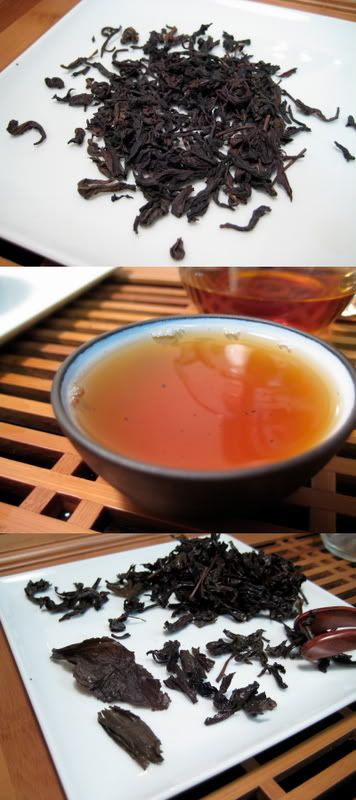Origin: Wenshan, Taiwan
Year: 1982
Vendor: Red Blossom Tea (Product page)
Price: $46.25 (4 oz.) / $12.50 (1 oz.)
This is one of the more interesting and puzzling teas I've come across lately, and it doesn't help that it is also in a category of tea I have just begun to explore. Anyway, on to my notes.
As soon as I opened the bag, I knew it was going to be an interesting experience drinking this tea. Smells of various spices, molasses, and notably peppermint blasted their way into my nose. After the initial reaction of "what the hell?" I remembered fellow bloggers commenting on the "spice" aroma of Red Blossom's aged sheng puerh.
 Are these things related? A common storage issue, perhaps? Anyway, such inquiries are purely speculative and presumably not why you are reading this, so let's continue.
Are these things related? A common storage issue, perhaps? Anyway, such inquiries are purely speculative and presumably not why you are reading this, so let's continue.Most of the spice seems to disappear once water hits the leaf, but the mint carried on well into the session. Actually, it was a pretty short session-- this tea didn't seem to have much endurance, at least not in my first attempt to brew it. With 6.5g of leaf in a 100mL gaiwan, it only went for 5 good infusions before getting weak.
What struck me about this tea was how much it tasted like puerh. I don't have the experience to say whether it tasted more like aged puerh or shupu, but it was in that range. It was not at all what I expected. It had a smooth texture, earthy, malty flavor and aftertaste, and mint like I mentioned earlier (The mint wasn't at all like the camphor I've tasted in some puerh, in case you are wondering, it almost tasted like it was flavored). This tea really didn't even begin to taste like a typical aged oolong until the end of the session, though the wet leaf and gaiwan lid smelled like oolong the whole time– weird. There was a good throatiness to the tea, and left a tingling minty taste/flavor on the back of my throat. There may have been some qi, but I wasn't sweating so it wasn't too strong.
The wet leaf was fairly surprising– there are large, full leaves here. While welcome, I haven't seen this in aged oolong before. Red Blossom notes on the product page that it hasn't been roasted for 25 years, perhaps this has something to do with it. (As a side note, Andy and I were wondering whether this meant never roasted, or just never re-roasted.)
Once I got past the weirdness, I decided that I do like this tea. I'm not sure I would buy a lot of it, but it is certainly good for switching things up a bit every now and then.


Very interesting tea. I've only had the "Wild Leaf" 1993 mao cha from Red Blossom, but this review is surprisingly reminiscent of that tea. I'm wondering how long you steeped it for those 5 infusions?
ReplyDeleteLately I've been surprised by some of my Sheng samples: finding that sometimes less is more. There are a couple of teas that I wrote off months ago (including the Hou De 1990's "Sun Dried" mao cha) as boring or unpleasant that have suprised me lately when I've used less leaf and less time.
Strangely, these teas have sprung to life in ways that I never noticed before. I assume that it is the reduced time/leaf that precipitated the change, but one can never rule out changes in the leaf itself over a few months or, for that matter, changes in me and my level of understanding. I seem to remember similar "less is more" surprises with some more volatile oolongs also.
Of course, less is usually just less. I refer only to a couple of isolated instances. Still, an aged light oolong seems like one of those unstable teas that could yield a similar surprise, especially given the rather substantial quantity of leaf you reference using.
Then again, as MarshalN likes to point out about sheng, using less can yield an acceptable brew of almost anything, while more leaf and time highlights all the flaws and merits.
Less is less, more is more, more is less, less is more. You know, maybe all this tea is just addling my brain! Ooo, better yet, maybe I'm achieving some kind of Asian enlightenment -- fat chance!
In any event, thanks for another nice post.
Salsero,
ReplyDeleteI ordered that 1993 mao cha as well, but I haven't tried it yet.
I steeped this one for 18s, 31s, 40s, 45s, and 50s. I will try brewing with less leaf -- Andy actually recommended the same thing-- I just have to overcome the "more is more" mentality gained from my recent attempts to brew yancha by to MarshalN's method (though I only got it to work a couple times).
Anyway, thanks for the suggestion, as usual. :)